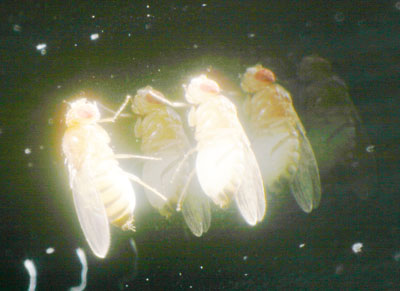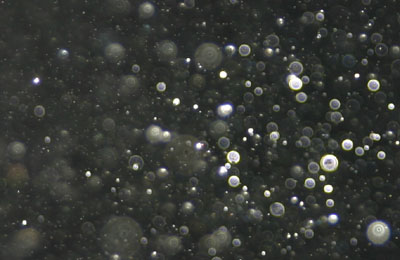
Nature photography is still a bit slow yet and the weather’s been going back and forth, so I’m just tossing out this curiosity from last year.
Seen here is a vain fruit fly, Drosophila genus, on the bathroom mirror. I’ve definitely done sharper, better shots, but this one has a distinctive property. You’ll notice that there is one view from the back, and three from the underside. The one from the back is the fly itself, while the other three are reflections in the mirror. Since this was taken at an angle to the glass, the brightest reflection is the main one, staggered away from the fly by the thickness of the glass since the reflective coating is on the back side.
So how did there come to be two more images? Well, it’s tricky. The faint image between the two bright ones (the real fly and its main reflection) is a reflection of the fly itself from the top surface of the glass. But the other, at far right, came from the main reflection itself reflecting from the underside of the glass, and off the mirrored backing again, before making it to the camera. It is a reflection of a reflection of a reflection, the light zig-zagging its way to us.
I had originally thought that the first faint image (second image counting from the left) was also a secondary reflection that coincidentally lined up perfectly with the fly’s feet, but realized as I wrote this post that the viewing angle would not have permitted a secondary reflection of the main reflection (third image from left) to be staggered in that direction. Another interesting realization is that I only have such good illumination on the underside of the fly because the camera strobe, above and to the left, bounced from the mirrored backing itself.
 Pondering this led to another thought, and a brief experiment shown here. Tweaking the brightness curves almost off the scale in Photoshop revealed yet another reflection staggered further right (you will note I did not remove the mirror spots in this image.) The light had dropped too faint to make it easily discernible, but the digital sensor still captured it. Sometimes there are subtle traces captured in digital images that can be brought out with editing, and I’ve used this to evaluate several ‘ghost’ and ‘UFO’ photos (which is not often appreciated.)
Pondering this led to another thought, and a brief experiment shown here. Tweaking the brightness curves almost off the scale in Photoshop revealed yet another reflection staggered further right (you will note I did not remove the mirror spots in this image.) The light had dropped too faint to make it easily discernible, but the digital sensor still captured it. Sometimes there are subtle traces captured in digital images that can be brought out with editing, and I’ve used this to evaluate several ‘ghost’ and ‘UFO’ photos (which is not often appreciated.)
 Now for some more photographic reflection trivia. This next pic is a portion of a frame taken while living in Florida, a time-exposure at night on black & white film. An effect called “halation” is plainly visible, the halos around the bright lights of the streetlamps. Also visible are starburst patterns, occasionally seen in star photographs, which is an artifact of using a small aperture – I’m leaving this for a later post, because I’m still doing research on how exactly this occurs. So for now, I’ll stick with the halos because I can tell you precisely how this happens.
Now for some more photographic reflection trivia. This next pic is a portion of a frame taken while living in Florida, a time-exposure at night on black & white film. An effect called “halation” is plainly visible, the halos around the bright lights of the streetlamps. Also visible are starburst patterns, occasionally seen in star photographs, which is an artifact of using a small aperture – I’m leaving this for a later post, because I’m still doing research on how exactly this occurs. So for now, I’ll stick with the halos because I can tell you precisely how this happens.
Let’s start with how lenses work; for ease of illustration, we’ll use a single point light source like a star or small bright light. The light that it emits expands everywhere, in a globe surrounding the source, so no matter where we stand we can still see it. The camera lens collects every part of that globe that strikes its front glass surface, and we all know that lenses bend light – essentially, all of the light that comes through the lens is focused down, concentrated back into a single point right where it contacts the focal plane, the film or digital sensor. This means the incoming light from the star actually forms a cone between lens and focal plane; the lens forms the base of the cone while the film/sensor sits precisely on the point. It is worth noting that all light through a lens does this, but it’s easier to imagine with a single point of light. (See also this page for more illustrations.)
Since photons are not solid objects, they won’t interfere with one another like solid matter does, and if nothing is at the tip of the cone to intersect them, they re-diverge past the point into a cone facing the other way. If the focal plane falls on either side of the precise focal point, that tip of the cone(s), you won’t see a nice point of light like the original star, you’ll get a circle from the cross section of the cone wherever the focal plane intersects.
 Now the fun. The emulsion of film is not perfectly opaque, and can let a little bit of light shine through it. So even when a bright light source is perfectly focused on the emulsion, which sits on the front surface of the backing acetate of film, some light goes through, re-diverging into another cone. This light can bounce off of the back of the film, or the pressure plate in the camera which holds the film flat, and reverses direction to contact the emulsion layer again from the back side. Now it’s out-of-focus, however – even that tiny bit of additional distance is enough to defocus noticeably in the scale of a 35mm film frame – and what results is a halo around the light source. If you go back up and look at the B&W image again, you’ll see the halos are all the same size, regardless of the apparent brightness of the lights; in some cases it’s almost overwhelmed by the flare.
Now the fun. The emulsion of film is not perfectly opaque, and can let a little bit of light shine through it. So even when a bright light source is perfectly focused on the emulsion, which sits on the front surface of the backing acetate of film, some light goes through, re-diverging into another cone. This light can bounce off of the back of the film, or the pressure plate in the camera which holds the film flat, and reverses direction to contact the emulsion layer again from the back side. Now it’s out-of-focus, however – even that tiny bit of additional distance is enough to defocus noticeably in the scale of a 35mm film frame – and what results is a halo around the light source. If you go back up and look at the B&W image again, you’ll see the halos are all the same size, regardless of the apparent brightness of the lights; in some cases it’s almost overwhelmed by the flare.
Most films have an anti-halation layer to help prevent this, and though the film I used (Ilford Delta 400) was supposed to be among them, it might simply have been overwhelmed by the amount of light admitted by the long exposure.
The flare is a curious effect as well, since there can be several causes. Both film and digital can be affected by light scatter from the lens, where the glass causes minute amounts of light to deflect from the focusing path slightly – this is often only seen in cases of over-exposure where the cumulative amounts of light are captured. Film can suffer from two additional effects. The first is where the halides in the emulsion, which crystallize when contacted by light, can generate a ‘sympathetic’ response in neighboring portions that are not receiving as much light, producing a result vaguely like using too much ink. And the second, very similar to the lens effect, is where light that passes through the emulsion can get scattered by the film base itself.
 It is worth noting that both flare, and the circles caused by unfocused point light sources, are often mistaken for UFOs and ghosts and other paranormal things. These effects can occur anytime, and often do, but because they involve diffuse light they’re usually overwhelmed by the sharper, more intense light from the focused parts of the image, and are most noticeable only when small bright points of light exist against a dark background where no other light interferes. Many intrepid ghost hunters with no knowledge of simple optics capture ‘orbs’ when their strobes illuminate airborne dust too close to the camera to be focused, visible because the rest of the frame is dark. It’s a very easy effect to duplicate; the image seen here was created with corn starch blown into the air. Either that or my apartment was haunted out the ass…
It is worth noting that both flare, and the circles caused by unfocused point light sources, are often mistaken for UFOs and ghosts and other paranormal things. These effects can occur anytime, and often do, but because they involve diffuse light they’re usually overwhelmed by the sharper, more intense light from the focused parts of the image, and are most noticeable only when small bright points of light exist against a dark background where no other light interferes. Many intrepid ghost hunters with no knowledge of simple optics capture ‘orbs’ when their strobes illuminate airborne dust too close to the camera to be focused, visible because the rest of the frame is dark. It’s a very easy effect to duplicate; the image seen here was created with corn starch blown into the air. Either that or my apartment was haunted out the ass…



















































